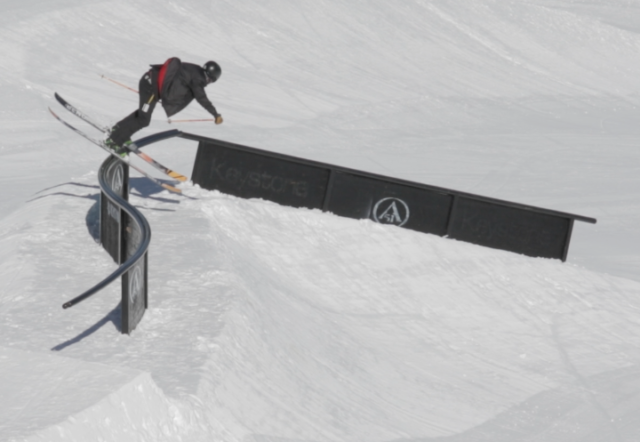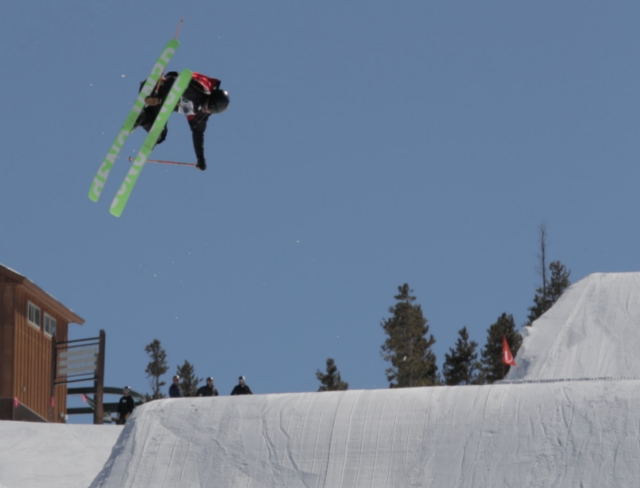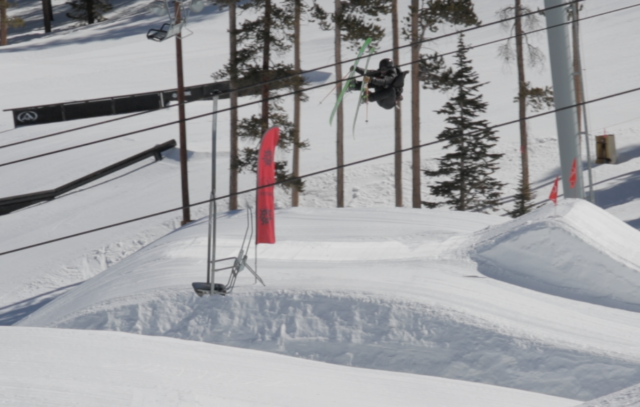
Ski: 2019-2020 ON3P Magnus 102, 186 cm
Available Lengths: 171, 176, 181, 186 cm
Blister’s Measured Tip-to-Tail Length: 186.7 cm
Stated Weight per Ski: 2100 grams
Blister’s Measured Weight per Ski: 2126 & 2136 grams
Stated Dimensions: 131-102-126 mm
Blister’s Measured Dimensions: 131.1-102.3-126.1 mm
Stated Sidecut Radius: 19.4 meters
Measured Tip & Tail Splay (ski decambered): 79 mm / 67 mm
Measured Traditional Camber Underfoot: ~2 mm
Core: Bamboo + 2” Unidirectional Carbon Stringers (top & bottom) + Fiberglass Laminate
Base: 1.8 mm 4001 Durasurf
Factory Recommended Mount Point: -2.25 cm from center; 91.1 cm from tail
Mount Tested: -1 cm from center
Boots / Bindings: Dalbello Il Moro T ID / Look Pivot 14
Test Locations: Keystone, Breckenridge, Arapahoe Basin, & Steamboat, CO
Reviewer: 5’9″, 150 lbs
Days Skied: 8
[Note: Our review was conducted on the 18/19 Magnus 102, which was not changed for 19/20, apart from graphics.]
Intro
For the 18/19 season, ON3P is tweaking their freestyle lineup, and introducing the new Magnus 102 to complement the current Magnus 90. As you are about to see, the Magnus 102 is quite unlike any other park ski we’ve reviewed.
ON3P still offers the Kartel series — their more general all-mountain freestyle series, which includes the Kartel 116, Kartel 108, and Kartel 96 (which replaces the Kartel 98 for 18/19).
The Magnus 102 stands as ON3P’s contribution to the growing category of wider, park-specific skis that range from 95 to 105 mm underfoot.
While plenty of skiers have been riding wider all-mountain skis (and sometimes even powder skis) in the park since Andy Mahre and Pep Fujas competed at X-Games on K2 Hellbents, the widening of waist widths among park-specific skis has been a relatively recent phenomenon. While most park skis rarely broke the 90 mm threshold 5 years ago, 95+ mm park skis are now quite commonplace.
In this category, the Magnus 102 is up against a number of popular skis, including the K2 Poacher, Armada Edollo, Faction Candide 2.0, Line Blend, and a host of others. Magnus Graner has become famous for his ridiculously impressive butters and presses, so how does the Magnus 102 compare to other buttery, wider park skis? Should it even be put into the same category as skis like the Line Blend or Armada Edollo?
And since the Magnus and Kartel lines seem pretty similar, who should be buying a Magnus, and who should be buying a Kartel?
Here’s what ON3P says about the new Magnus 102:
“Brand new for 2019, the Magnus 102 brings our ten years of rockered park ski development into the 100mm+ waist range. Designed for skiers who find themselves taking their park skills all over the mountain, it provides a more stable platform and top end stability over our dedicated park option – the Magnus 90. A close-to-center mount keeps the ski balanced & light on your feet, while a tighter turn radius support a playful, buttery style.”
Note: though the Magnus 102 is technically an 18/19 ski, it is already for sale on ON3P’s site, along with all of ON3P’s 18/19 skis.
Shape / Rocker Profile
One of the defining characteristics of the Magnus 102 is its rocker profile. This ski has a ton of tip and tail splay, and very deep rocker lines for a ski that’s only 102 mm underfoot. And when combined with its flex pattern (see below), the rocker profile of the Magnus 102 translates to a unique experience on snow.
In terms of shape, the Magnus 102 looks pretty similar to the Kartel 96, with a bit of taper at the tips and tails, but nothing too drastic in when it comes to the shape.
Flex Pattern
Hand flexing the Magnus 102, here’s how we’d characterize its flex pattern:
Tips: 7.5
Shovels: 8.5
In Front of Toe Piece: 9-9.5
Underfoot: 10
Behind Heel Piece: 9.5-8.5
Tails: 7.5-7
The Magnus 102 is a pretty stout ski, noticeably stiffer than the Armada Edollo, Faction Candide 2.0, and much stiffer than the Line Blend, though the 102’s flex pattern does ease off a bit in the tips and tails near the contact points. Still, the Magnus 102 is quite stiff throughout the entire profile — especially for a park ski — and I have had to apply a lot of force to flex into its tips and tails.
Compared to the Kartel 108, the Magnus 102 is a bit softer in the tails and has a more symmetrical flex pattern. But the front halves of both skis are quite similar when it comes to the flex pattern.
Rails / Jibs
So yeah, it’s fair to say that the Magnus 102 is a really beefy ski, and this is immediately noticeable in its swing weight when spinning onto or off of rails. Particularly in the 186 cm length, it takes a bit of extra muscle to whip around compared to other skis of similar widths like the Faction Candide 2.0. And based on how Magnus Graner actually skis (i.e. lots of butters and presses), I also expected the Magnus 102 to be a bit easier of a ski, especially in regard to the amount of effort required to get the ski to butter or press.
But when I did provide enough input to flex into the ski, it provided a lot of energy and pop.

Because the ski is so damp and stiff, I really enjoyed how easily the rockered tips and tails blasted through slushy spring snow late in the day between features when skiing both switch and forward. The Magnus 102 immediately brought to mind the RMU Apostle 98 in its ability to charge around the park at speed in spring conditions.
Considering just how stiff the Magnus 102 really is, it retained a surprising playful poppiness on jibs. I wouldn’t put the Magnus 102 in the same category as the Edollo or even the Candide 2.0, but it’s notably more playful and has more pop than the RMU Apostle 98 — or any of the stiffer competition-style skis like the Salomon NFX or Fischer Nightstick.
Factory (De)Tune
Also of note, the pair that I received for this review came with the most aggressive underfoot detune job I’ve ever seen, which ON3P says comes standard on the Magnus 90 and Magnus 102. I felt comfortable sliding wooden rails and concrete jersey barriers from the very first morning on the Magnus. Starting with such a thorough detuning will also undoubtedly do wonders for the longevity of the edges (see the durability section further down for more).
Jumps
On jumps, I found the Magnus 102’s pronounced rocker profile and stiff flex pattern to be somewhat at odds with each other. On one hand, the burly underfoot platform feels extremely solid and stable when I’d land a trick perfectly on the balls of your feet. But the moment I’d land the slightest bit backseat when landing forward — or a bit nose-heavy when landing switch — the 102’s heavily rockered tips and tails weren’t doing me any favors. Of course, this can be said of any rockered ski, but the Magnus 102’s’ significant splay (compared to other skis in this class) accentuated this, and the ski felt a touch more prone to washing out on landings than skis like the Candide 2.0 and J Skis Allplay.

And again, while the Magnus 102’s flex pattern does get a bit softer toward the tips and tails, those tips and tails are still quite stiff compared to the Magnus 102’s counterparts like the Faction Candide 2.0, Line Blend, and Armada Edollo. But the 102’s stiffness definitely helps to mitigate the challenges posed by the large tip and tail splay — in other words, if its tails were any softer, I think the Magnus would be a very challenging ski to use for hitting big jumps.
Here’s a video of Scott on the Magnus 102 and a few other skis he’s been reviewing. Unfortunately, Scott recently blew out his MCL (see the last shot in this edit), so we wish him a very speedy recovery. (Video credit goes to Gavin Rudy)
All-Mountain Performance
The same qualities of the 186 cm Magnus 102 that I highlighted in the jump section carried over outside of the park as well. The Magnus 102 is pretty damp for a park ski, and I could definitely charge hard on it when I stayed on / drove the shovels and pressured the front of the ski. But if I lost my balance or got back seat, I found it challenging to recover and get back into the front of my boots due to the heavily rockered tail.
The important caveat here is that, outside of the park, I get along really well with skis that have stiffer tails and little tail rocker (e.g., the RMU Apostle 98, and every competition mogul ski I grew up training and competing on). And I’m not sure that I’ve ever spent much time on a ski with tails that are as rockered and as stiff as the Magnus 102’s. The only similar ski that’s coming to mind right now is the Kartel 108, which also has a lot of tail rocker and is pretty stout, though I haven’t skied it. So if you are accustomed to skis like the Kartel 108, I suspect that the Magnus 102 will feel immediately more intuitive to you than it has to me.
With that said, if you stay forward or centered on the ski, the Magnus can blast through crud and float pretty well in powder for only having a 102 mm waist width — in crud and powder, I found its rocker profile to be a plus.
It’s also worth noting that the Magnus 102’s swingweight that felt a bit cumbersome to me when spinning on and off rails was also noticeable in tight trees and in moguls. So if you’re accustomed to skiing lighter, more tip-tapered park skis (like the Line Tom Wallisch Pro or Faction Prodigy 2.0) in trees and moguls, I suspect you’ll feel the same. However, if you’re coming from burlier all-mountain freestyle skis (like the Kartel 108) I imagine that the Magnus 102 will feel plenty quick.
Durability
I am extraordinarily hard on my equipment. I like doing a lot of disasters and other high-impact rail tricks, and as a result, I tend to destroy skis awfully quickly.
[Editor’s Note: He’s not kidding. When Scott turns in a park ski review and doesn’t start by telling us that he’s already broken the ski, we’re pretty shocked. He holds the record — by a mile — for most skis broken by any Blister reviewer.]
So I have to say that I’ve been really impressed with the Magnus 102’s durability so far. I have yet to find an edge crack after 8 days of hard testing. Without question, this is partially attributable to the out-of-box detune. ON3P’s 2.5mm x 2.5mm edges are also the thickest of any ski we’ve reviewed, which is worth noting.
Beyond a complete lack of edge cracks, I have found no signs of impending delamination, there has been extremely little topsheet damage, and after hitting a number of rocks, I haven’t had any base issues, either.
Weighing in on a ski’s durability is tricky; there are a lot of factors that might lead to one pair of skis blowing up a lot faster than the rest of the batch. But overall, I’m extremely impressed so far with the Magnus 102 I’ve been testing.
Who’s It For?
Because it’s unlike most skis on the market, it’s tough to place the Magnus 102. If you love super light skis that have super low swing weights, the Magnus 102 is probably not for you. But if you have the strength to really lay into the ski, the Magnus 102 can function as a playful, buttery park ski. Its combination of a stiff flex pattern and large tip and tail splay makes it a bit challenging on big jumps, but a lot of skiers might really enjoy this pairing in an all-mountain jib ski.

I think the Magnus 102 could be a good option for people that have been using a wider, heavily rockered ski like the Kartel 108 in the park or as an all-mountain jib ski, but find it to be a bit too much ski for that purpose. The Magnus 102 and Kartel 108 share many similarities in their flex patterns and rocker profiles, but the Magnus 102 is obviously a bit narrower, has a more symmetrical flex pattern with slightly softer tips and tails, comes with ON3P’s agressive park detune, and has a more forward mount point. All these traits make the Magnus 102 a slightly “easier” ski and one better suited to the specific demands of park skiing, and also make it a bit more maneuverable in tight spots (though the Magnus 102 is still a lot burlier than your typical park ski). Because of the Magnus 102’s aggressive detune and very progressive mount point, if you aren’t spending a lot of time in the park, the Kartel 96 or Kartel 108 might be better options.
Bottom Line
The ON3P Magnus 102’s combination of a stout flex pattern and very generous rocker profile is unique when it comes to park skis. Overall, the Magnus 102 is a durable, burly park / all-mountain jib ski that is also playful if you’re willing to muscle through its stiffer flex pattern. While its significant tip and tail splay doesn’t make it an ideal big jump ski, the Magnus 102 can still thrive in a variety of terrain, features, and conditions.

Very nice write up – thanks! Healing vibes also – the fall looked pretty cringe worthy.
On a different note – can we look forward to the usual photos to accompany this well written review?
Will you be doing a Magnus 90 review as well? I can’t find one for the updated ’19 model anywhere!
No Rocker pics?
what is the difference between this and the new magnus